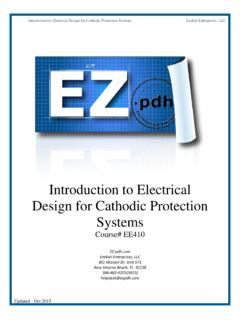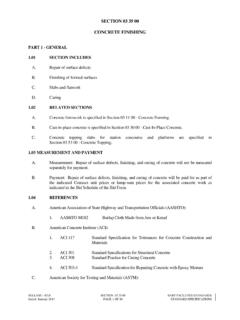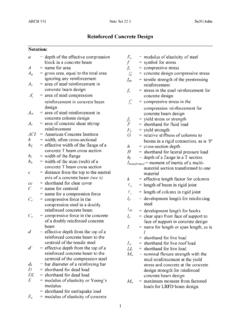Transcription of Design Of Heavy Duty Concrete Floor Slabs On Grade
1 Design Of Heavy duty Concrete Floor Slabs On Grade Course# ST-702 Ezekiel Enterprises, LLC 301 Mission Dr. Unit 571 New Smyrna Beach, FL 32128 386-882-EZCE(3923) Ezekiel Enterprises, LLC UFC 3-320-06A 1 March 2005 UNIFIED FACILITIES CRITERIA (UFC) Concrete Floor Slabs ON Grade SUBJECTED TO Heavy LOADS APPROVED FOR PUBLIC RELEASE; DISTRIBUTION UNLIMITED UFC 3-320-06A 1 March 2005 1 UNIFIED FACILITIES CRITERIA (UFC) Concrete Floor Slabs ON Grade SUBJECTED TO Heavy LOADS Any copyrighted material included in this UFC is identified at its point of use. Use of the copyrighted material apart from this UFC must have the permission of the copyright holder. ARMY CORPS OF ENGINEERS (Preparing Activity) NAVAL FACILITIES ENGINEERING COMMAND AIR FORCE CIVIL ENGINEER SUPPORT AGENCY Record of Changes (changes are indicated by \1\ .. /1/) Change No. Date Location This UFC supersedes TM 5-809-12/AFM 88-3Ch15, dated 25 August 1987.
2 The format of this UFC does not conform to UFC 1-300-01; however, the format will be adjusted to conform at the next revision. The body of this UFC is the previous TM 5-809-12, dated 25 August 1987. UFC 3-320-06A 1 March 2005 2 FOREWORD \1\ The Unified Facilities Criteria (UFC) system is prescribed by MIL-STD 3007 and provides planning, Design , construction, sustainment, restoration, and modernization criteria, and applies to the Military Departments, the Defense Agencies, and the DoD Field Activities in accordance with USD(AT&L) Memorandum dated 29 May 2002. UFC will be used for all DoD projects and work for other customers where appropriate. All construction outside of the United States is also governed by Status of forces Agreements (SOFA), Host Nation Funded Construction Agreements (HNFA), and in some instances, Bilateral Infrastructure Agreements (BIA.) Therefore, the acquisition team must ensure compliance with the more stringent of the UFC, the SOFA, the HNFA, and the BIA, as applicable.
3 UFC are living documents and will be periodically reviewed, updated, and made available to users as part of the Services responsibility for providing technical criteria for military construction. Headquarters, Army Corps of Engineers (HQUSACE), Naval Facilities Engineering Command (NAVFAC), and Air Force Civil Engineer Support Agency (AFCESA) are responsible for administration of the UFC system. Defense agencies should contact the preparing service for document interpretation and improvements. Technical content of UFC is the responsibility of the cognizant DoD working group. Recommended changes with supporting rationale should be sent to the respective service proponent office by the following electronic form: Criteria Change Request (CCR). The form is also accessible from the Internet sites listed below. UFC are effective upon issuance and are distributed only in electronic media from the following source: Whole Building Design Guide web site Hard copies of UFC printed from electronic media should be checked against the current electronic version prior to use to ensure that they are current.
4 AUTHORIZED BY: _____ DONALD L. BASHAM, Chief, Engineering and Construction Army Corps of Engineers _____DR. JAMES W WRIGHT, Chief Engineer Naval Facilities Engineering Command _____ KATHLEEN I. FERGUSON, The Deputy Civil Engineer DCS/Installations & Logistics Department of the Air Force _____Dr. GET W. MOY, Director, Installations Requirements and Management Office of the Deputy Under Secretary of Defense (Installations and Environment) ARMY TM 5-809-12 AIR FORCE AFM 88-3, Chap. 15 DEPARTMENTS OF THE ARMY ANDTHE AIR FORCE TECHNICAL MANUALCONCRETE Floor SLABSON Grade SUBJECTEDTO Heavy LOADSDEPARTMENTS OF THE ARMY, AND THE AIR FORCEAUGUST 1987*TM 5-809-1/AFM 88-3, Chap. 15iTECHNICAL OF THE ARMYAIR FORCE MANUALAND THE AIR FORCENO. 88-3, CHAPTER 15 WASHINGTON, , 25 August 1987 Concrete Floor Slabs ON Grade SUBJECTED TO Heavy LOADSCHAPTER OF Floor slab ON Grade live OF Floor slab REQUIREMENTSV ehicular live slab types and slab reinforced * This manual supersedes TM 5-809-12/AFM 88-3, Chapter 15, dated 1 April 5-809-12/AFM 88-3, Chap.
5 15iiPageAPPENDIX FOR COMPUTING THE ALLOWABLEWALL LOADS NEAR CENTER OF slab OR NEARKEYED OR DOWELED OF FIGURESF igure3-1 Widths of thickened Slabs and slabedge conditions under wall curves for Concrete floorslabs by Design curves for Concrete floorslabs for Heavy for odd-shaped thickness for slabs5-5 Typical Floor slab joint joints for reinforced andnonreinforced Floor sealant joint construction joints forconcrete Floor construction joints for concetefloor slab Design forvehicular in Concrete Floor curves for fiber-reinforcedconcrete Floor slab by Design curves for fiber-reinforcedconcrete Floor slab for Heavy curves for fiber-reinforcedconcrete Floor deflection for jointed fiber-reinforced Concrete Floor OF TABLEST able3-1 Maximum allowable stationary live thickness of thickened floorslab for wall load near center or near keyed or doweled allowable wall load nearfree values of modulus of categories for Design spacing of transversecontraction size and 5-809-1/AFM 88-3, Chap.
6 151-1 CHAPTER loads. Dynamic and/or oscillatoryThis manual prescribes the criteria for the Design ofconcrete Floor Slabs on Grade in buildings for heavyloads and is applicable to all elements responsiblefor military construction. Heavy loads in buildingssuch as warehouses include moving loads, stationarylive loads, and wall concepts, practical applications, basis ofdesign, and Design procedures for Heavy loads arediscussed in this manual. Related criteria for light-loaded areas such as office spaces are separatelytreated in TM 5-809-2/AFM 88-3, Chap. 2. Criteriafor areas subjected to vibratory loadings areincluded in TM 5-81 8-1/AFM 88-7, Chap. 1. Fordesign criteria outside the scope of this manual,industry standards are following definitions have been adopted for on Grade . Concrete slab supported di-rectly on foundation loads. Loads which consist of (compa-rable) forklift axle load of 5 kips or less andstationary live loads less than 400 pounds per loads.
7 Loads which consist of any oneof the following: moving live loads exceeding aforklift axle load of 5 kips, stationary live loadsexceeding 400 pounds per square foot, andconcentrated wall loads exceeding 600 pounds perlinear load. Concentrated loads imposed bywalls or load. All the materials composing thepermanent structure, including permanent wall loadsand all equipment that is fixed in load. Loads imposed by the use andoccupancy of the structure.(1)Moving live load. Loads imposed by ve-hicular traffic such as forklift trucks.(2)Stationary live load. Loads imposed bymovable items such as stored of significant load. The effects of stationary live,dead, and wall loads and moving live loads. Deadloads of Floor Slabs on Grade are soils. Soils which exhibit undesirableproperties for construction uses such as high com-pressibility or swell slab .
8 Concrete slab resting ongrade containing minimal distributed steel, usually ofwelded wire fabric (WWF), for the purpose oflimiting crack width due to shrinkage and tempera-ture slab . Concrete slab resting on gradecontaining steel reinforcement which consists ofeither a welded wire fabric or deformed reinforcingsteel Floor Slabs on Grade are subjected to avariety of loads and loading conditions. The designprocedure includes determining slab thickness basedon moving live loads and then checking adequacy ofslab thickness for stationary live load. The designprocedure separately includes determining thicknessof slab under wall load. The entire Design procedureis based on a working stress concept. Stresses in-duced by temperature gradients and other environ-mental effects are taken into account by the assign-ment of working stresses. Working stresses havebeen established empirically based on experiencegained in roadway and airfield pavement perform-ance A contains a list of references used in 5-809-1/AFM 88-3, Chap.
9 152-1 CHAPTER 2 BASIS OF Floor slab ON Grade expansion and contraction of the concreteThe structural Design of a Concrete Floor slab ongrade is primarily controlled by the stresses causedby moving live loads and in some cases thestationary loads. Stresses in Floor Slabs on graderesulting from vehicular loads are a function of floorslab thickness, vehicle weight and weightdistribution, vehicle wheel or track configuration,modulus of elasticity and Poisson*s ratio ofconcrete, and modulus of subgrade reaction ofsupporting material. The volume of traffic duringthe Design life is important for fatigue consid-erations. The Floor slab Design procedure presentedThe maximum allowable stationary live load is lim-herein is based on limiting the critical tensile stressesited by both the positive bending moment stressproduced within the slab by the vehicle loading, asunder the load and the negative bending momentin TM 5-822-6/AFM 88-7, Chap.
10 1. Correlationstresses occurring at some distance from the between theory, small-scale model studies, bending moments. Stresses due toand full-scale accelerated traffic tests have shownpositive bending moment are relatively simple tothat maximum tensile stresses in Floor Slabs willcompute by using Westergaard*s analysis* of elasti-occur when vehicle wheels are tangent to a freecally supported plates. An appropriate safety factoredge. Stresses for the condition of the vehilcleis applied to determine allowable stresses due towheels tangent to an interiorjoint where the twothese loads because environmentally imposedslabs are tied together are less severe than a freestresses must also be accounted for whenedge because of the load transfer across the twoconsidering stationary Slabs . In the case of Floor Slabs , the bending moments.














